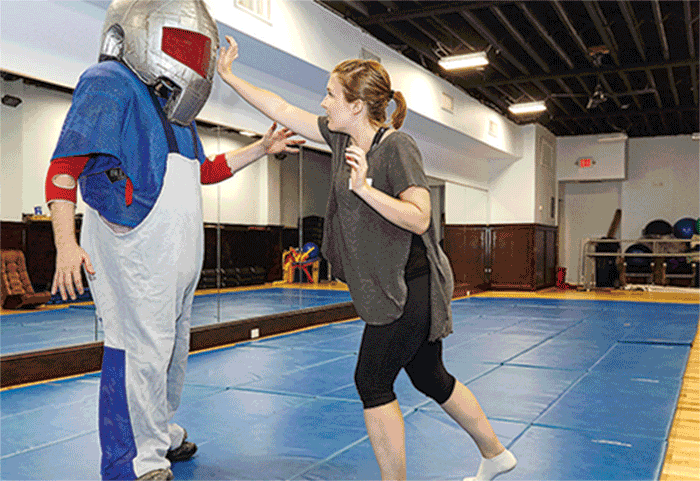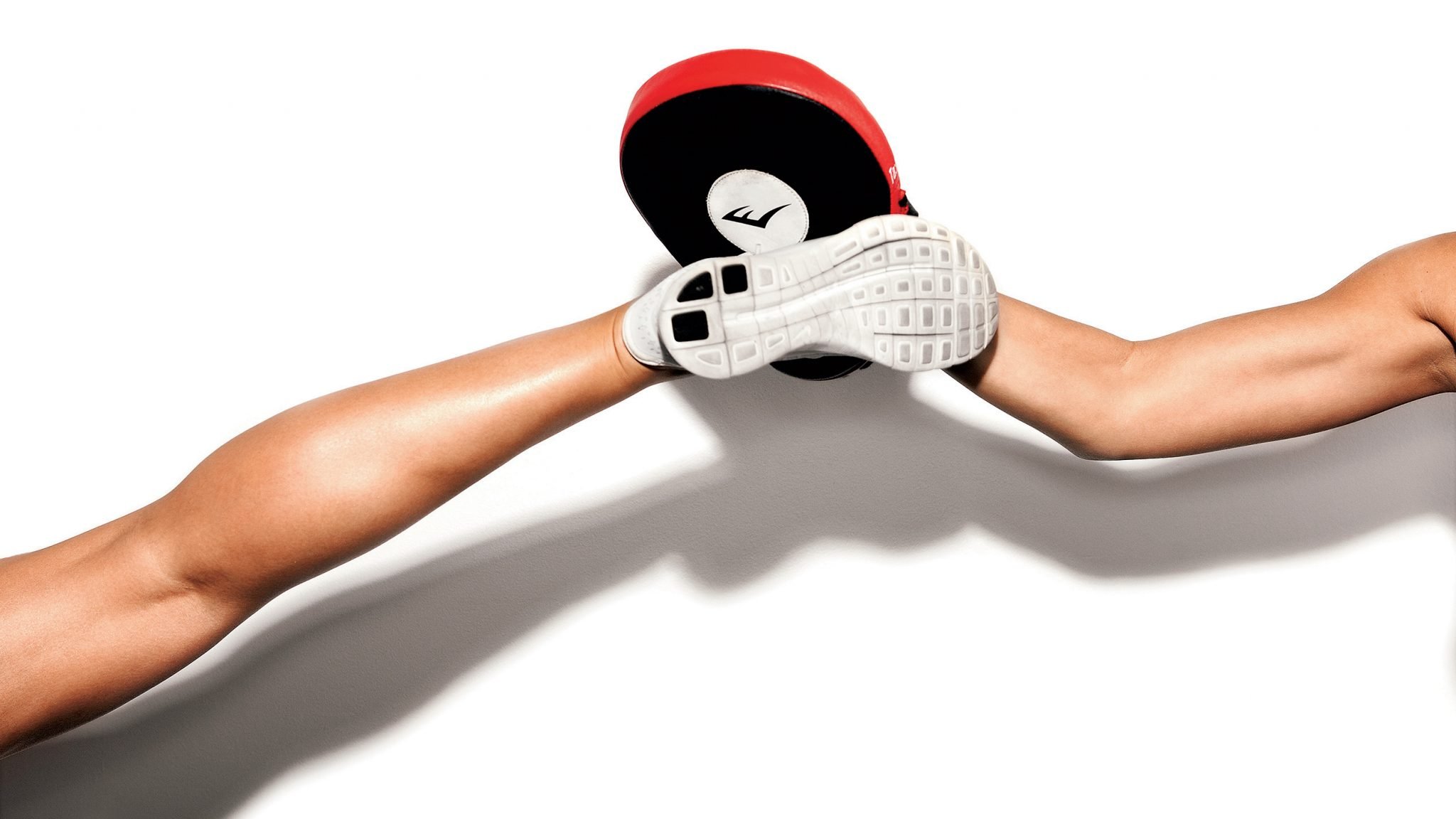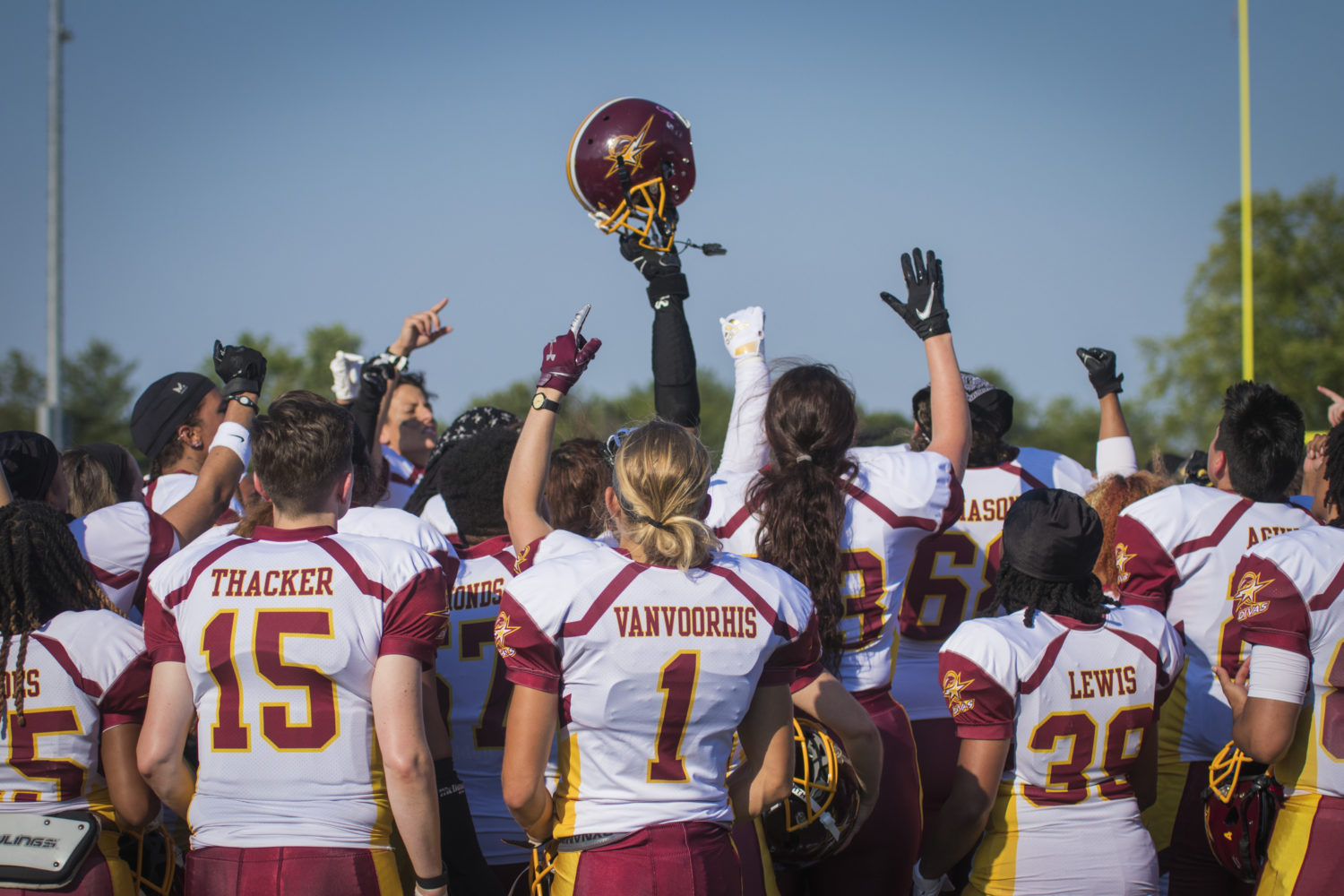When I started looking for a self-defense class, what I was really looking for was one that would teach me how to fight. I go on solo runs most mornings and often walk home alone in the dark from the Metro. If someone were to attack me, I wanted to know, could I take him?
The options for fight training in Washington are plentiful: One school alone teaches Thai boxing, Brazilian jiujitsu, and mixed martial arts. Others focus on boxing, karate, and tae kwon do.
I signed up for Krav Maga—partly because it’s totally lethal, partly because it’s what Jessica Jones’s blond friend learns in the Netflix series. It’s a simple yet brutally effective type of hand-to-hand combat, originally designed for Israel’s military. While Krav Maga was a terrific workout—my calves were on fire the day after my first class—I discovered that it takes years to learn how to knock a gun from a mugger’s hand or fight off multiple assailants.
Traditional self-defense tends to fall into one of two categories. The first is learning how to fight. The second is learning a list of rules that women are told to follow, most of which start with “never”: Never go out alone at night. Never drink at parties. Never wear revealing clothing. Never talk to strangers.
But what if the way we traditionally think of self-defense is wrong?
Sun Tzu, author of The Art of War, said: “The supreme art of war is to subdue the enemy without fighting.” The same applies to self-defense. While knowing how to fend off an attacker with your fists is valuable if it comes to that, my hope is that it never comes to that. Because no one leaves a fight unscathed.
That’s one of the core principles of a modern strain of self-defense training for women, which some call feminist self-defense or empowerment-based self-defense. Rather than training women how to fight off a bad guy who jumps them in an alley or scolding them for wearing what they want to wear, feminist self-defense takes into account that women are more likely to be attacked by someone they know, not a stranger. According to the Department of Justice’s National Crime Victimization Survey, only 38 percent of nonfatal attacks were committed by strangers, while more than 70 percent of homicides were committed by someone known to the victim, such as an acquaintance, neighbor, or coworker.
“Empowerment self-defense classes are really what we call evidence-based, in that they look at the ways that women are assaulted and the things that work for them,” says Jocelyn Hollander, who heads the University of Oregon’s department of sociology and has studied the effects of this kind of training.
Lauren Taylor, a DC instructor behind the program Defend Yourself, is a champion of this form of instruction. “What distinguishes a class like Defend Yourself from what’s labeled self-defense is the focus on boundary-setting, assertiveness, dealing with everyday things,” says Taylor. “It’s not just about the best way to do a knee to the groin—although we teach you the best way to do a knee to the groin—but things that happen in everyday life, be it street harassment or an overly boundary-crossing coworker.”
Taylor offers an entire class on assertiveness, the tenets of which she weaves into her other classes. Her handout for verbal self-defense includes tips such as “Tell them what you want. Say, for example, ‘Stand over there’ or ‘Stop touching me.’ ”
These skills are also practiced in role-play scenarios at DC Impact Self Defense, run by Carol Middleton. Middleton has been teaching in the area since 1976 and is kind of the Yoda of local teachers. She’s Lauren Taylor’s former instructor and has consulted for Irene van der Zande, who founded a self-defense program for children called Kidpower, which has two local branches.
Middleton began her self-defense journey by training in martial arts. When I sat down in a primarily female semicircle around Middleton for the first module of her course, she told us about her come-to-Jesus moment years ago when a man followed her into her apartment. Though she had studied karate for two years and competed in tournaments, she had no idea how to defend herself. Today she can count on two hands the mistakes she made—such as leaving the door unlocked behind her—that could have helped her avoid the situation.
Instead of a lesson in delivering a karate chop, one of the first exercises we tried was how to walk with confidence. We strode past one another—heads high, eyes focused, pace neither too fast nor too slow—with a nod and a calm “hey.” When it comes to street harassment, Taylor says that a quick greeting is one way to head off an offensive remark. “Which acknowledges them as a human being and makes you a human being, and hopefully makes them less likely to say something disrespectful.”
With our “power walks” down, Middleton moved on to other verbal techniques, particularly de-escalation, which can be used to calm an aggressor. Regarding someone who could turn violent, Middleton says: “Don’t make them wrong, don’t disrespect them, don’t challenge them, don’t try to control them, don’t threaten them.” Arguing with an aggressor “just gives them the emotional energy to start a full-out fight.”
We practiced this rule in role-play. One woman had to deflect the advances of a creepy coworker at the end of a night shift, a teenage participant calmly explained to her “boyfriend” that she wasn’t interested in having sex right then, and another talked her way out of being cornered by a drunk guy at a party.

When it was my turn, the male assistant instructor’s suggested scenario hit me right in the gut: I had to say no to a coworker who was trying to dump his assignment on me. As I stammered about the projects I was already working on, I realized something: Learning to say no to something as seemingly harmless as a work assignment has little to do with physical protection but everything to do with learning to set boundaries and say what you are or aren’t comfortable with.
One of Taylor’s former students, Lydia Watts, was in her early forties when she enrolled in the class, thinking she’d learn how to protect herself from street harassment or assault. The most powerful thing she says she learned in the class, however, was that it’s okay to say no: “It seems a little crazy that it took me that long to realize that I could say that to somebody at age 42.”
Whether it was the person who kept trying to talk to her at the bus stop or her boss—a man a couple of decades her senior who frequently passed his responsibilities on to her—Watts says she picked up the ability to “own my space.” She relied on the assertiveness skills she’d practiced in class to draw parameters with her boss by saying, “I want to help. I want to be in partnership with you, but I cannot take on responsibilities that are not my own.”
Nasreen Alkhateeb, a contractor who works in film production out of Northwest DC and another former student of Taylor’s, had always thought of herself as confident and assertive. During the class, however, she realized that her go-to response to harassment was to ignore rather than confront it.
Following the class, she says, she had an unpleasant, unprofessional encounter with someone she was working with. Rather than saying nothing at the moment and stewing over it later, she responded immediately, laying out work boundaries.
Boundary-setting is an important piece of feminist self-defense because it can help women avoid situations in which assault could occur. At the University of Oregon, Hollander conducted a study that compared 117 students enrolled in an empowerment-based self-defense course with 169 students who didn’t take the course. A year after the class, Hollander surveyed both groups again. Among the 108 women who took the follow-up survey but hadn’t taken the class, three reported being raped in the intervening year. None of those who’d had training reported a rape.
Perhaps the more telling result from Hollander’s study was the number of attempted rapes. Of those who hadn’t taken the course, more than 8 percent said they’d experienced an attempted rape. Among the women who’d taken the class, 2.7 percent said they’d encountered an attempted rape. Hollander interprets these numbers to mean that the boundary-setting and verbal skills they learned helped the women not only stop attacks in process but also keep would-be attacks at bay: “It’s not just that they’re being assaulted and fighting back effectively—it’s that they’re not being assaulted in the first place. That’s what we want.”
Charlene Senn, who has researched male violence against women at the department of psychology at the University of Windsor in Ontario, saw similar findings from her larger study, published by the New England Journal of Medicine in 2015. Senn surveyed first-year students at three Canadian colleges who had participated in a 12-hour Enhanced Assess, Acknowledge, Act Sexual Assault Resistance program. The goal of the program was “being able to assess risk from acquaintances, overcome emotional barriers in acknowledging danger, and engage in effective verbal and physical self-defense.”
A year after the class, when the participants were surveyed again, their reports of completed rape registered 5.2 percent to the control group’s 9.8 percent. As with Hollander’s study, the incidence of attempted rape among participants, 3.4 percent, was lower than in the control group, which reported 9.3 percent.
Because rape and attempted rape will never disappear, empowerment self-defense classes still teach physical skills. Unlike martial arts, feminist self-defense focuses on moves designed for women’s bodies, emphasizing kicking and kneeing assailants because women’s legs are usually stronger than their arms.
Another advantage: Empowerment classes can be completed in weeks, not the years it takes to master martial arts.
“I don’t think taking a Krav Maga class will give you the immediate skills that people might be looking for,” says Hollander. “It also won’t give you the kinds of verbal self-defense skills that can really help you to prevent assaults. I’m not saying those classes are bad—that’s just not where I’d start.”
While I was reporting this article, a coworker asked if looking into women’s self-defense had made me more paranoid. After discovering empowerment-based self-defense, I’d say it’s had the opposite effect. It’s made me more aware but also more confident—both in my ability to protect myself and in the fact that my confidence is one of the things that may keep me safe.
This article appears in the November 2016 issue of Washingtonian.














